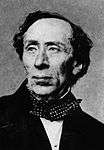The Wild Swans
| "The Wild Swans" | |
|---|---|
|
Illustration by Vilhelm Pedersen, Andersen‘s first illustrator (1850) | |
| Author | Hans Christian Andersen |
| Original title | "De vilde svaner" |
| Country | Denmark |
| Language | Danish |
| Genre(s) | Fairy tale |
| Published in | Fairy Tales Told for Children. New Collection. First Booklet. 1838. |
| Publication type | Fairy tale collection |
| Publisher | C. A. Reitzel |
| Media type | |
| Publication date | 2 October 1838 |
| Preceded by | "The Steadfast Tin Soldier" |
The Wild Swans is a literary fairy tale by Hans Christian Andersen about a princess who rescues her eleven brothers from a spell cast by an evil queen. The tale was first published on 2 October 1838 as the first installment in Andersen's Fairy Tales Told for Children by C. A. Reitzel in Copenhagen, Denmark. It has been adapted to various media including ballet, television, and film.
Synopsis

In a faraway kingdom, there lives a widowed king with his twelve children: eleven princes and one princess. One day, he decides to remarry. He marries a wicked queen who was a witch. Out of spite, the queen turns her eleven stepsons into swans (they are allowed to become human by night) and forces them to fly away. The queen then tries to bewitch their 15-year-old sister, Elisa, but Elisa's goodness is too strong for this, so the queen has Elisa banished. The brothers carry Elisa to safety in a foreign land where she is out of the reach of her stepmother.
There, Elisa is guided by the queen of the fairies to gather stinging nettles in graveyards to knit into shirts that will eventually help her brothers regain their human shapes. Elisa endures painfully blistered hands from nettle stings, and she must also take a vow of silence for the duration of her task, for speaking one word will kill her brothers. The king of another faraway land happens to come across the mute Elisa and falls in love with her. He grants her a room in his castle where she continues her knitting. Eventually he proposes to crown her as his queen and wife, and she accepts.
However, the Archbishop is chagrined because he thinks Elisa is herself a witch, but the king will not believe him. One night Elisa runs out of nettles and is forced to collect more in a nearby church graveyard where the Archbishop is watching. He reports the incident to the king as proof of witchcraft. The statues of the saints shake their heads in protest, but the Archbishop misinterprets this sign as confirmation of Elisa's guilt. The Archbishop orders to put Elisa on trial for witchcraft. She can speak no word in her defence and is sentenced to death by burning at the stake.
The brothers discover Elisa's plight and try to speak to the king but fail. Even as the tumbril bears Elisa away to execution, she continues knitting, determined to keep it up to the last moment of her life. This enrages the people, who are on the brink of snatching and destroying the shirts when the swans descend and rescue Elisa. The people interpret this as a sign from Heaven that Elisa is innocent, but the executioner still makes ready for the burning. Then Elisa throws the shirts over the swans, and the brothers return to their human forms. Elisa is now free to speak and tell the truth, but she faints from exhaustion, so her brothers explain. As they do so, the firewood around Elisa's stake miraculously take root and burst into flowers. The king plucks the topmost flower and presents it to Elisa, and they are married.
Adaptations
- The Wild Swans, a Soviet traditionally-animated feature film.
- Wild Swans, a ballet by Elena Kats-Chernin.
- Stories to Remember: The Wild Swans, a animated short film narrated by Sigourney Weaver.
- Sekai meisaku dôwa: Hakuchou no ouji (The Wild Swans: The Prince of the Swans), an anime film by Toei Animation.
- Jessica Jung's concept photo for Girls' Generation's third studio album The Boys was inspired by Elisa.
- The Springfield Swans by Caroline Stevermer and Ryan Edmonds, in Snow White, Blood Red (edited by Ellen Datlow and Terri Windling) retells the story in a baseball contest.
See also
External links
| Wikimedia Commons has media related to The Wild Swans. |
| Wikisource has original text related to this article: |
| Danish Wikisource has original text related to this article: |
- De vilde svaner. Original Danish text
- The Wild Swans. English translation by Jean Hersholt

